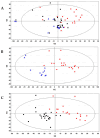Redox Balance and Inflammatory Response in Follicular Fluids of Women Recovered by SARS-CoV-2 Infection or Anti-COVID-19 Vaccinated: A Combined Metabolomics and Biochemical Study
- PMID: 39125969
- PMCID: PMC11313332
- DOI: 10.3390/ijms25158400
Redox Balance and Inflammatory Response in Follicular Fluids of Women Recovered by SARS-CoV-2 Infection or Anti-COVID-19 Vaccinated: A Combined Metabolomics and Biochemical Study
Abstract
To date, not many studies have presented evidence of SARS-CoV-2 infecting the female reproductive system. Furthermore, so far, no effect of the administration of anti-COVID 19 vaccines has been reported to affect the quality of oocytes retrieved from women who resorted to assisted reproduction technology (ART). The FF metabolic profiles of women who had been infected by SARS-CoV-2 before IVF treatments or after COVID-19 vaccination were examined by 1H NMR. Immunochemical characterization of proteins and cytokines involved in the redox and inflammatory pathways was performed. The increased expression of SOD2 and NQO1, the lack of alteration of IL-6 and CXCL10 levels, as well as the increased expression of CD39, suggested that, both sharing similar molecular mechanisms or proceeding along different routes, the redox balance is controlled in the FF of both vaccinated and recovered women compared to controls. The lower amount of metabolites known to have proinflammatory activity, i.e., TMAO and lipids, further supported the biochemical results, suggesting that the FF microenvironment is controlled so as to guarantee oocyte quality and does not compromise the outcome of ART. In terms of the number of blastocysts obtained after ICSI and the pregnancy rate, the results are also comforting.
Keywords: COVID-19; NMR-based metabolomics; SARS-CoV-2; biomarkers; female fertility; follicular fluid; inflammation; oxidative stress.
Conflict of interest statement
The authors declare no conflicts of interest.
Figures






References
-
- Madni S.A., Sharma A.J., Zauche L.H., Waters A.V., Nahabedian J.F., 3rd, Johnson T., Olson C.K. CDC COVID-19 Vaccine Pregnancy Registry Work Group. CDC COVID-19 Vaccine Pregnancy Registry: Design, data collection, response rates, and cohort description. Vaccine. 2023;42:1469–1477. doi: 10.1016/j.vaccine.2023.11.061. - DOI - PMC - PubMed
-
- Alviggi C., Esteves S.C., Orvieto R., Conforti A., La Marca A., Fischer R., Andersen C.Y., Bühler K., Sunkara S.K., Polyzos N.P., et al. POSEIDON (Patient-Oriented Strategies Encompassing IndividualizeD Oocyte Number) group. COVID-19 and assisted reproductive technology services: Repercussions for patients and proposal for individualized clinical management. Reprod. Biol. Endocrinol. 2020;18:45. doi: 10.1186/s12958-020-00605-z. - DOI - PMC - PubMed
MeSH terms
Substances
LinkOut - more resources
Full Text Sources
Medical
Research Materials
Miscellaneous

